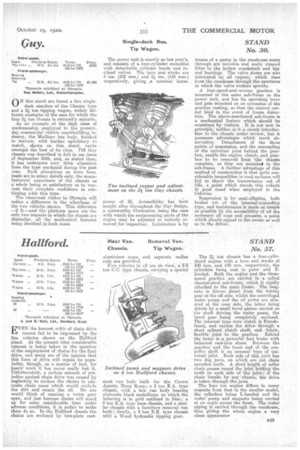Hanford.
Page 51

If you've noticed an error in this article please click here to report it so we can fix it.
Meat Van. Removal Van.
Chassis. Tip Wagon.
STAND No. 57.
-VITEN the keenest critic of chain drive 124 cannot fail to be impressed by the fine vehicles shown on the Hanford stand. At the present time considerable interest is being taken in the question of the employment of chains for the final drive, and many are of the opinion that this form of drive will regain its popularity, though, a.s a matter of fact, for heavy. work it has never really lost it. Unfortunately, a certain amount of preindica against chain drive was caused by • neglecting to enclose the chains in adequate chain cases which would exclude the dirt and retain the oil. No one would think of running a worm gear open, and just because chains will stand up for some considerable time under adverse conditions, it is unfair to make them do so. in the Hanford chassis the chains are enclosed by two-piece cast. aluminium cases, and separate radius rods are .provided.
Five vehicles in all are on view, a 2-3 ton CC, type chassis, carrying a special meat van body built for the Crown Agents, Hong Kong; a 3 ton E A. type chassis, with a box van body bearing elaborate black medallions, on which the lettering is in gold outlined in blue; a 4 ton E.A. type bare chassis, and a similar Chassis with a furniture removal van body; finally, a 5 ton E.E. type chassis with a Wood hydraulic tipping gear.
The 4 tort chassis has a four-cylindered engine with a bore and stroke of 100 mm. and 140 mm. respectively, the cylinders being cast in pairs • and Theaded. Both the engine and the threespeed gearbox are carried in a rolled channel-steel sub-frame, which is rigidly attached to the main frame. The magneto is driven direct from the timing gear •at the off side, whilst the centrifugal water pump and the oil pump are situated at the near sidi, the latter being driven by a-small bevel pinion carried on the shaft driving the water pump, the bevel gear being completely enclosed. The internal type cone clutch is Ferodofaced, and carries the drive through' a short split-led clutch shaft and fabric, flexible joint to the gearbox. Behind the latter is a powerful foot brake with balanced cast-iron shoes, Between the gearbox and the front end of the propeller shaft is an unusual type of universal joint. Each side of this joint has two dog jaws, on which are cut chain sprocket teeth. A short length of roller chain passes round the joint holding the teeth on each side of the joint ; if the chain breaks by any chance, the drive is taken through the jaws. The four ton engine differs in many respects from that in the smaller model, the cylinders being L-headed and the water pump and magneto being carried at An angle across the front. The water piping is carried through the crankcase, thus giving the whole engine a very clean appearance.












































































